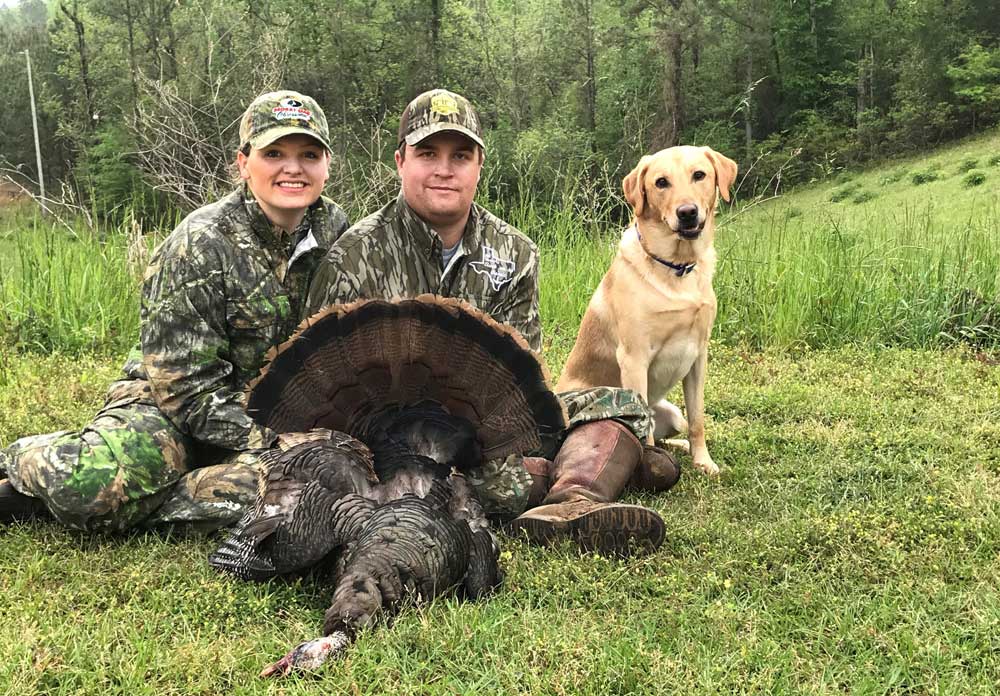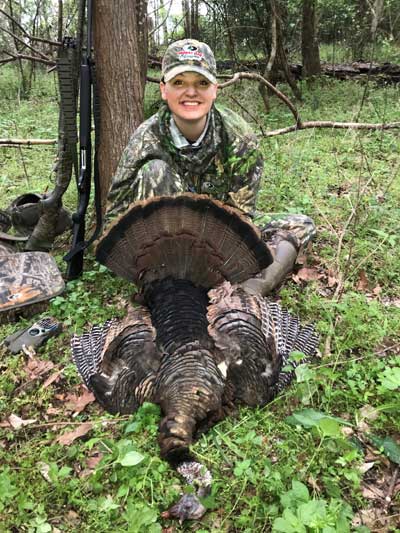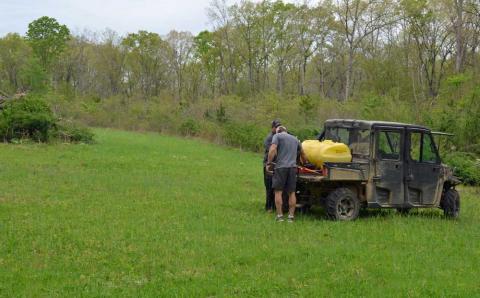provided by John Phillips
Mossy Oak Pro Calvin Perryman lives in Troy, Alabama, and took his first turkey when he was 6 years old. Today, at age 30, Perryman primarily hunts private lands in Alabama in Wilcox, Dallas, Pike and Bullock counties. Originally from Camden, Alabama, he has some family land he also hunts there.

My wife had only been turkey hunting one time before this hunt. I truly wanted to try to get her a turkey. On this hunt, we were able to get on turkeys that were really gobbling. Also there were turkeys that we could call to and make them gobble. We sat down quickly. I could tell by the way the turkeys were gobbling that two were coming to us. I was sitting right beside Samara as the turkeys approached. Samara turned to me and held up two fingers to indicate there were two gobblers coming. Well, I'm ashamed to admit it, but I scolded her about holding up those two fingers and moving with turkeys on their way to us. I was afraid they’d spot the movement. I let her know that I was aware there were two turkeys coming and for her to just sit tight and not move until they arrived.
The turkeys came up a steep hill to us, and I thought the turkeys were going to pop up just as they came over the top of the hill. But instead they moved around to the left, and I was able to see one turkey for just an instant. I thought they would come to the left, which would give Samara a relatively easy shot. However, the birds turned around and came from the right. Since Samara was a right-handed shooter, I knew this shot would be really difficult for her to make. I watched as she moved when those two turkeys went behind a tree or thick bush and couldn’t see her. She was sliding to her right. I was able to see what she was seeing, because we were sitting so closely together. I could coach her about when to move and when not to move, and if she moved around the tree, I did too.
 Samara had to move to her right about three feet to get her gun up and make the shot. Three feet is a long way when you're sliding around a tree, and two turkeys were only 30 yards from you. When the birds finally came up on the same level where we were, they instantly spotted us. The first gobbler putted and started to run. But Samara made a great shot, the gobbler went down, and the second tom got away. I was really proud of her for making a good shot and downing one of those turkeys before they got away. She was shooting a 20-gauge with TSS No. 9 shot. Although I mostly hunt with a 12-gauge, I like that 20-gauge, particularly for Samara because it doesn’t have heavy recoil or sound as loud as my 3-1/2 inch Magnum does. Before I gave Samara the 20-gauge, I’d patterned it out to 55 yards. I knew that it would kill a turkey stone cold dead at that range.
Samara had to move to her right about three feet to get her gun up and make the shot. Three feet is a long way when you're sliding around a tree, and two turkeys were only 30 yards from you. When the birds finally came up on the same level where we were, they instantly spotted us. The first gobbler putted and started to run. But Samara made a great shot, the gobbler went down, and the second tom got away. I was really proud of her for making a good shot and downing one of those turkeys before they got away. She was shooting a 20-gauge with TSS No. 9 shot. Although I mostly hunt with a 12-gauge, I like that 20-gauge, particularly for Samara because it doesn’t have heavy recoil or sound as loud as my 3-1/2 inch Magnum does. Before I gave Samara the 20-gauge, I’d patterned it out to 55 yards. I knew that it would kill a turkey stone cold dead at that range.
What I Learned from My Hunt with Samara:
- A youngster or a person new to the sport of turkey hunting more than likely will do something wrong, but he or she won’t know what to do when a turkey’s moving toward him. When a person does do something wrong, don’t correct them harshly as I did Samara. Remember, at one time you were learning to turkey hunt, and you probably did the same thing wrong.
- I didn’t allow Samara to sit out in front of me when I was calling to a turkey. I sat right beside her, so I could tell her how the hunt was going, where the turkey was, what he was doing, and how she needed to adjust to be able to make the shot at the gobbler when he appeared.
- You need to brag on the newbie you're hunting with when he or she makes a good shot. Explain why shooting when they did resulted in their taking the tom.
- The one thing I've learned from taking new people turkey hunting is regardless of what happens, the new hunter needs to have a fun time, as well as learning how to turkey hunt. If the hunt isn’t enjoyable to that novice turkey hunter, there’s a good chance you may lose what may have been a great turkey-hunting buddy for many years.



























